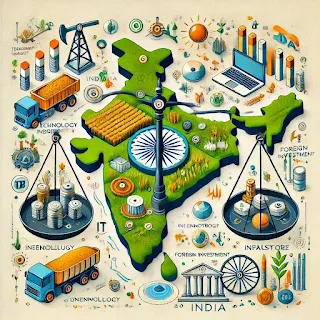In English
हिन्दी मे
भारत की सकल घरेलू उत्पाद (GDP) का विषय देश की आर्थिक प्रगति और विकास को समझने के लिए अत्यंत महत्वपूर्ण है। यह एक ऐसा पैमाना है जो देश की आर्थिक स्थिति और भविष्य की संभावनाओं को दर्शाता है। इस लेख में, हम भारत की GDP के मौजूदा आँकड़ों, इसकी संरचना, वृद्धि दर, प्रभाव डालने वाले कारकों, और भविष्य की संभावनाओं पर चर्चा करेंगे।
भारत की GDP के मौजूदा आँकड़े
भारत विश्व की पाँचवीं सबसे बड़ी अर्थव्यवस्था है। इसका GDP विश्व स्तर पर प्रभावशाली स्थान रखता है।
-
नाममात्र GDP (Nominal GDP):
नाममात्र GDP मौजूदा विनिमय दरों पर मापा जाता है। 2024 तक भारत की नाममात्र GDP लगभग 3.73 ट्रिलियन अमेरिकी डॉलर है। यह भारत को अमेरिका, चीन, जापान, और जर्मनी के बाद पाँचवें स्थान पर रखता है। -
क्रय-शक्ति समानता (Purchasing Power Parity, PPP):
PPP GDP मुद्राओं की क्रय शक्ति को ध्यान में रखते हुए मापा जाता है। 2024 तक भारत की PPP GDP लगभग 13.17 ट्रिलियन अमेरिकी डॉलर है, जो इसे चीन के बाद दूसरी सबसे बड़ी अर्थव्यवस्था बनाती है। -
दुनिया में रैंकिंग:
नाममात्र GDP के आधार पर भारत पाँचवें स्थान पर है, जबकि PPP GDP के आधार पर यह दूसरे स्थान पर है।
GDP का क्षेत्रीय और क्षेत्रवार वितरण
भारत की GDP का योगदान तीन प्रमुख क्षेत्रों से आता है: कृषि, उद्योग, और सेवा क्षेत्र।
- कृषि क्षेत्र (Agriculture Sector):
भारत की अर्थव्यवस्था में कृषि का महत्वपूर्ण योगदान है। यह GDP का लगभग 15-16% हिस्सा है।
- मुख्य फसलें: गेहूं, धान, कपास, गन्ना, और दलहन।
- कृषि क्षेत्र में लगभग 43% जनसंख्या कार्यरत है।
- औद्योगिक क्षेत्र (Industrial Sector):
औद्योगिक क्षेत्र GDP का लगभग 25-27% हिस्सा है।
- प्रमुख उद्योग: इस्पात, सीमेंट, कपड़ा, पेट्रोकेमिकल्स, और ऑटोमोबाइल।
- औद्योगिक क्षेत्र भारत के निर्यात और रोजगार में महत्वपूर्ण भूमिका निभाता है।
- सेवा क्षेत्र (Service Sector):
सेवा क्षेत्र भारत की GDP का सबसे बड़ा हिस्सा है, जो लगभग 53-55% योगदान देता है।
- इसमें बैंकिंग, आईटी, दूरसंचार, पर्यटन, और स्वास्थ्य सेवाएँ शामिल हैं।
- भारत का आईटी क्षेत्र वैश्विक स्तर पर अग्रणी है और निर्यात का बड़ा हिस्सा प्रदान करता है।
भारत की GDP वृद्धि दर
भारत की GDP वृद्धि दर पिछले कुछ वर्षों में अस्थिर रही है, लेकिन वैश्विक महामारी और अन्य आर्थिक चुनौतियों के बावजूद यह उभरती हुई अर्थव्यवस्था है।
-
2019-20:
COVID-19 महामारी से पहले, भारत की GDP वृद्धि दर 4.2% थी। -
2020-21:
महामारी के कारण GDP में -7.3% की गिरावट आई, जो भारतीय इतिहास में सबसे बड़ी आर्थिक गिरावट थी। -
2021-22:
महामारी के बाद आर्थिक सुधार से GDP में 8.7% की वृद्धि हुई। -
2023-24:
IMF और RBI के अनुसार, 2023-24 में GDP वृद्धि दर 6.1-6.3% रहने का अनुमान है।
भारत की GDP को प्रभावित करने वाले कारक
भारत की GDP को प्रभावित करने वाले कई कारक हैं। इनमें कुछ प्रमुख कारक निम्नलिखित हैं:
-
जनसंख्या और मानव संसाधन:
भारत की 1.4 अरब की जनसंख्या और बड़ी युवा जनसंख्या GDP वृद्धि के लिए एक बड़ा अवसर है। -
बुनियादी ढाँचा (Infrastructure):
सड़कें, रेलवे, और बंदरगाहों जैसे बुनियादी ढाँचे में निवेश GDP वृद्धि को बढ़ावा देता है। -
विदेशी निवेश (FDI):
भारत में 2023 तक लगभग 80 बिलियन अमेरिकी डॉलर का प्रत्यक्ष विदेशी निवेश हुआ है। -
तकनीकी प्रगति:
डिजिटल इंडिया और स्टार्टअप योजनाएँ भारत की अर्थव्यवस्था में तकनीकी योगदान को बढ़ावा दे रही हैं। -
वैश्विक व्यापार:
भारत का कुल निर्यात 2023 में लगभग 770 बिलियन अमेरिकी डॉलर था, जिसमें वस्त्र, फार्मा, और आईटी सेवाएँ शामिल हैं।
भारत की GDP पर प्रभाव डालने वाली चुनौतियाँ
भारत की GDP को बढ़ाने के लिए कई बाधाओं का सामना करना पड़ता है।
-
गरीबी और बेरोज़गारी:
भारत में गरीबी दर अभी भी अधिक है। बेरोज़गारी दर 2023 में लगभग 7-8% है। -
महंगाई (Inflation):
महंगाई दर 2023 में 6-7% थी, जो घरेलू खपत और बचत पर नकारात्मक प्रभाव डालती है। -
कृषि क्षेत्र की चुनौतियाँ:
मानसून पर निर्भरता और छोटे किसानों की समस्याएँ कृषि उत्पादन को प्रभावित करती हैं। -
ऊर्जा संकट:
ऊर्जा आपूर्ति और वितरण में सुधार की आवश्यकता है। -
वैश्विक मंदी:
विश्व स्तर पर आर्थिक मंदी और भू-राजनीतिक तनाव भारत के निर्यात और आर्थिक विकास पर प्रभाव डाल सकते हैं।
सरकार की नीतियाँ और योजनाएँ
भारत सरकार GDP को बढ़ाने के लिए विभिन्न नीतियाँ और योजनाएँ लागू कर रही है।
-
मेक इन इंडिया (Make in India):
इस योजना का उद्देश्य विनिर्माण क्षेत्र को बढ़ावा देना और रोजगार सृजन करना है। -
डिजिटल इंडिया (Digital India):
डिजिटल तकनीक को अपनाने से सेवाओं और व्यवसायों में तेजी आई है। -
प्रधानमंत्री आवास योजना:
गृह निर्माण और शहरी विकास के माध्यम से अर्थव्यवस्था को बढ़ावा दिया जा रहा है। -
GST:
वस्तु एवं सेवा कर (GST) ने भारत की कर प्रणाली को सरल बनाया है। -
उज्ज्वला योजना:
ऊर्जा क्षेत्र में सुधार और गरीबों को सस्ती ऊर्जा उपलब्ध कराना इस योजना का लक्ष्य है।
भारत की GDP वृद्धि के लिए संभावनाएँ
भारत में आर्थिक वृद्धि के लिए कई संभावनाएँ मौजूद हैं।
-
आईटी और डिजिटल अर्थव्यवस्था:
भारत का आईटी उद्योग निरंतर प्रगति कर रहा है और GDP में बड़ा योगदान दे सकता है। -
नवीकरणीय ऊर्जा:
सौर और पवन ऊर्जा में निवेश भारत की ऊर्जा सुरक्षा और आर्थिक विकास को बढ़ावा दे सकता है। -
रक्षा उत्पादन:
भारत का रक्षा उत्पादन और निर्यात क्षमता GDP में योगदान दे सकती है। -
पर्यटन:
भारत के समृद्ध सांस्कृतिक और ऐतिहासिक स्थलों का पर्यटन क्षेत्र में अधिक उपयोग किया जा सकता है। -
स्टार्टअप संस्कृति:
भारत में स्टार्टअप्स और उद्यमशीलता का विकास GDP में बड़ा योगदान दे सकता है।
निष्कर्ष
भारत की GDP देश की आर्थिक स्थिति का प्रतिबिंब है। हालांकि भारत एक उभरती हुई अर्थव्यवस्था है, लेकिन इसे अभी भी गरीबी, बेरोज़गारी, और बुनियादी ढांचे जैसी कई चुनौतियों का सामना करना पड़ रहा है।
सरकार की नीतियाँ, तकनीकी प्रगति, और वैश्विक व्यापार के माध्यम से भारत की GDP वृद्धि को और भी तेज किया जा सकता है। यदि भारत इन चुनौतियों का सामना कर सके और अपने संसाधनों का सही उपयोग कर सके, तो यह निकट भविष्य में दुनिया की तीसरी सबसे बड़ी अर्थव्यवस्था बन सकता है।

